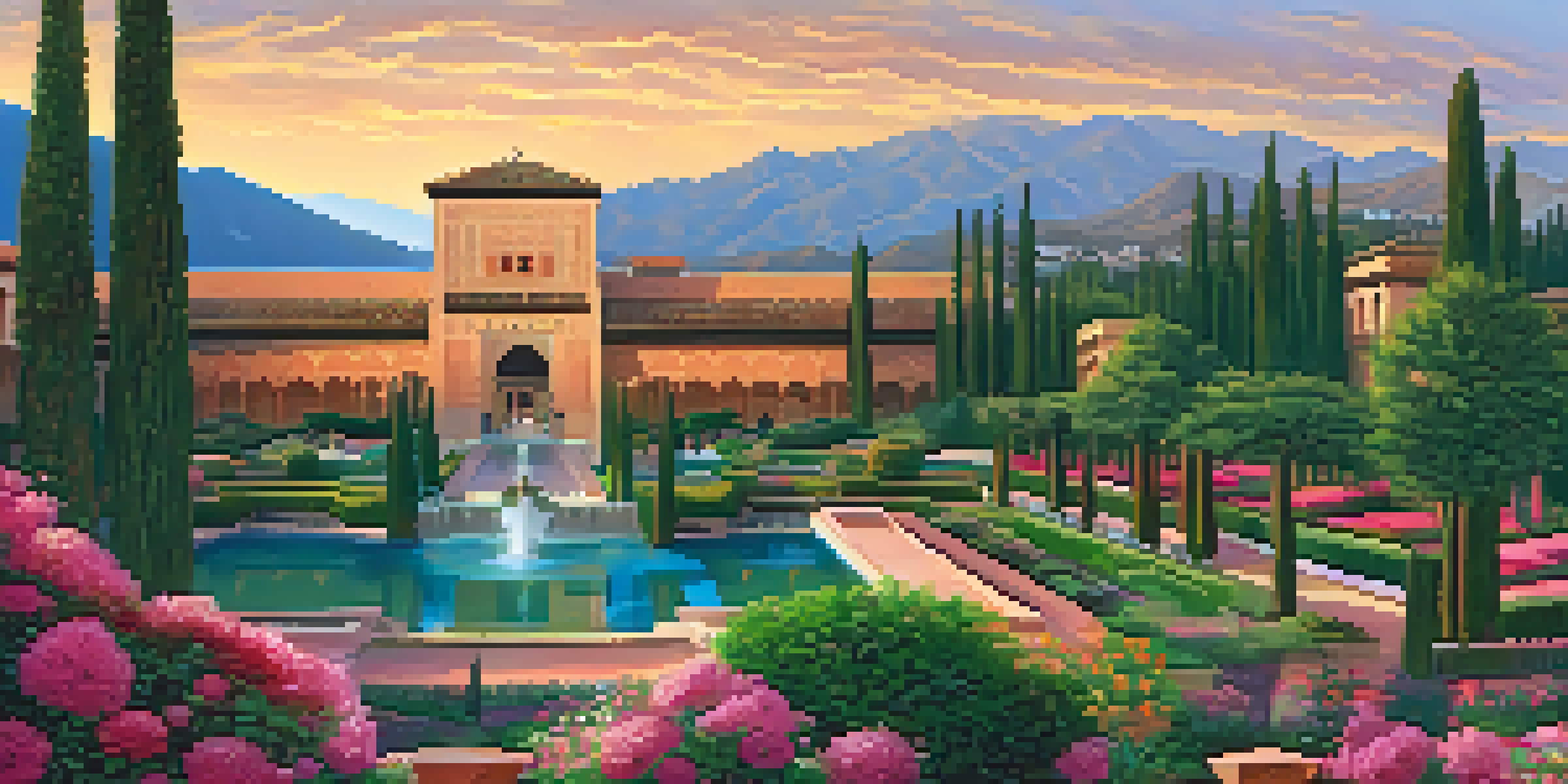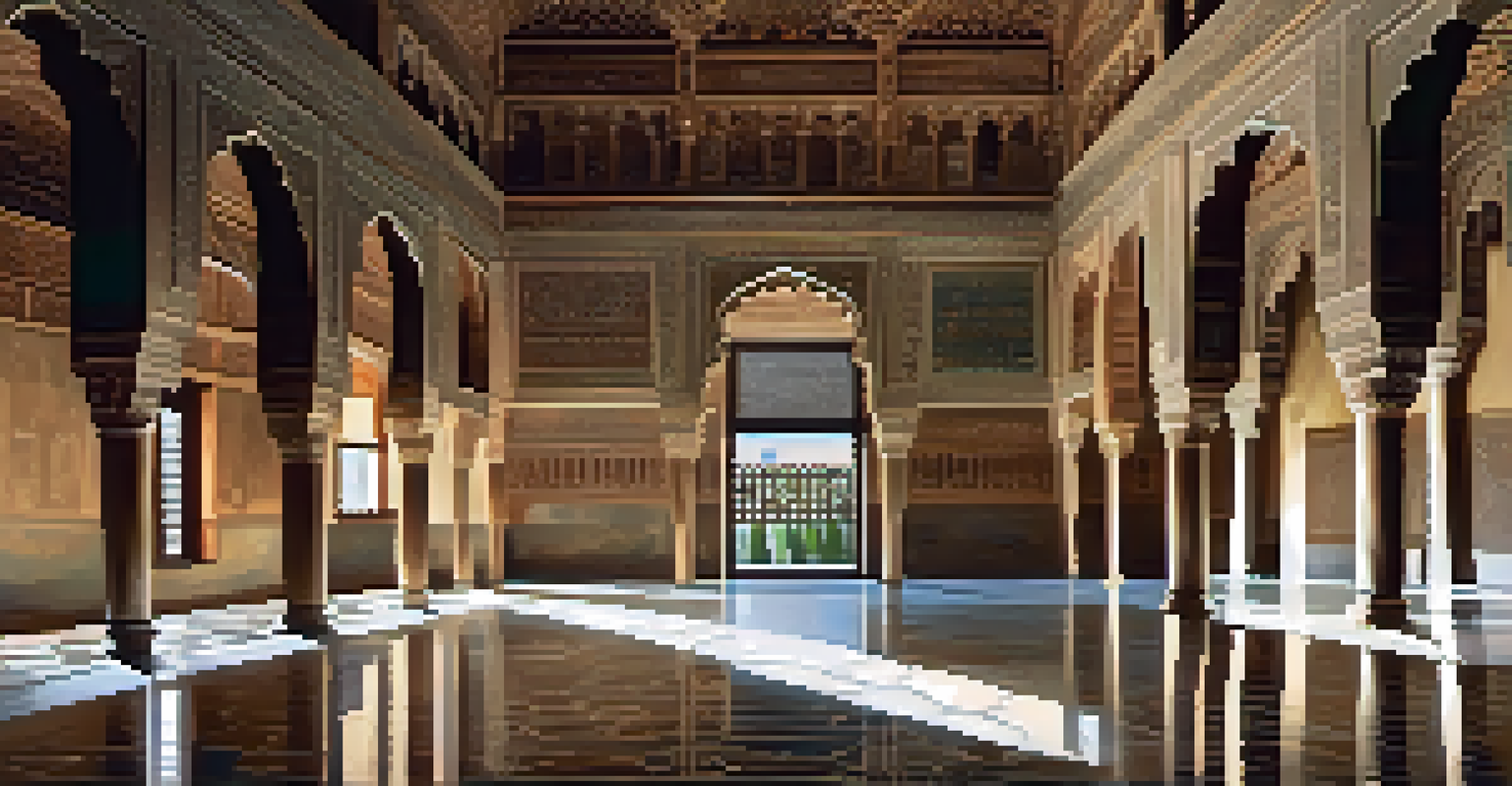The Alhambra: A Guided Tour of Spain's Moorish Jewel

A Brief History of The Alhambra
The Alhambra, perched on the rolling hills of Granada, has a rich history that dates back to the mid-13th century. Originally built as a modest fortress by the Nasrid dynasty, it evolved into a stunning royal palace that reflects the grandeur of Islamic architecture. This UNESCO World Heritage site tells the story of a vibrant period in Spanish history where cultures intertwined and flourished.
To be able to think freely, a man must be able to live freely.
The name 'Alhambra' translates to 'the red one,' likely referring to the reddish hue of its walls, especially at sunset. Over the centuries, it has witnessed the rise and fall of empires, serving as a refuge for Muslim rulers and, later, as a symbol of the Christian Reconquista. Each stone in its intricate walls whispers tales of the past, inviting visitors to step back in time.
Today, The Alhambra stands not only as a testament to Moorish design but also as a cultural crossroads where art, architecture, and history converge. Walking through its ancient halls, one can feel the essence of the generations that have walked before, making it a must-visit on any journey through Spain.
Architectural Wonders Within The Alhambra
As you enter The Alhambra, you're greeted by breathtaking architectural features that showcase the brilliance of Moorish design. The intricate tile work, known as 'azulejos,' creates mesmerizing patterns that captivate the eye and evoke a sense of harmony. These colorful ceramics not only serve as decoration but also symbolize the deep connection to nature and spirituality prevalent in Islamic art.

One of the highlights is the stunning Nasrid Palaces, where each room is a masterpiece in its own right. The Court of the Lions, for example, boasts an exquisite fountain surrounded by twelve marble lions, symbolizing strength and protection. The detailed stucco work and lush gardens further enhance the serene atmosphere, making it easy to lose track of time as you explore.
The Alhambra's Rich History
Originally built as a fortress in the 13th century, The Alhambra evolved into a stunning royal palace symbolizing cultural interplay in Spain.
Another architectural gem, the Hall of the Ambassadors, showcases a magnificent wooden ceiling that appears to float above you. This room was once the throne room for the Sultan and serves as a reminder of the opulence that defined this era. The Alhambra is truly a feast for the senses, with every corner revealing new surprises that reflect the ingenuity of its creators.
Exploring the Gardens of The Alhambra
The Generalife, the summer palace of the Nasrid rulers, offers a tranquil escape from the bustling city. Its gardens are a testament to the Islamic tradition of creating paradise on earth, filled with fragrant flowers, lush greenery, and serene water features. As you stroll through the pathways, you can hear the gentle sound of flowing water, enhancing the peaceful ambiance of the surroundings.
Architecture is a visual art, and the buildings speak for themselves.
One of the most iconic features of the Generalife is the Water Stairway, a cascading series of fountains that lead visitors through the gardens. This clever use of water not only serves as a cooling element but also symbolizes the importance of water in Moorish culture. Each step you take feels like a step deeper into a living artwork, where nature and architecture coalesce beautifully.
The gardens of The Alhambra also offer stunning views of the Alhambra itself and the Sierra Nevada mountains in the background. Whether you're an avid photographer or simply a lover of nature, this space provides countless opportunities to capture the beauty of the landscape. It's the perfect place to pause, reflect, and soak in the enchanting atmosphere.
The Cultural Significance of The Alhambra
The Alhambra is not just a remarkable architectural site; it is a cultural symbol for both Spain and the Muslim world. Its construction represents a pinnacle of Islamic art and architecture, showcasing the achievements of the Nasrid dynasty. Visitors to the Alhambra can appreciate how this site embodies the historical interactions between different cultures, particularly during the Middle Ages.
This cultural crossroads is evident in the influence of Christian and Jewish architectural styles that can be seen alongside traditional Islamic elements. For instance, the addition of Christian symbols after the Reconquista highlights the complex narrative of coexistence and conflict in Spanish history. The Alhambra serves as a reminder of this rich tapestry, making it a vital part of Spain's heritage.
Architectural Marvels Abound
The Alhambra showcases exquisite Moorish design, with highlights including the intricate tile work and the majestic Nasrid Palaces.
Today, The Alhambra continues to inspire artists, writers, and musicians worldwide. Its beauty has been captured in countless works of art and literature, demonstrating its enduring legacy. By visiting this remarkable site, you become part of a story that transcends time, connecting you to the many who have been captivated by its charm.
Visiting The Alhambra: Essential Tips
Planning your visit to The Alhambra requires some foresight, as tickets can sell out quickly, especially during peak tourist seasons. It's wise to book your tickets online in advance to secure your preferred time slot. This will allow you to explore the site at a leisurely pace without the stress of long queues or sold-out days.
When you arrive, consider joining a guided tour to enhance your experience. Knowledgeable guides can provide insights into the history and architecture that you might miss on your own. Alternatively, audio guides are available if you prefer to explore at your own pace while still gaining valuable context about the site.
Lastly, wear comfortable shoes and be prepared for a fair amount of walking. The Alhambra is expansive, and you'll want to take your time soaking in every detail. Don't forget to bring a camera to capture the stunning views and intricate designs that make The Alhambra a true jewel of Moorish architecture.
The Alhambra in Modern Culture
In contemporary culture, The Alhambra has transcended its historical roots to become a symbol of beauty and inspiration. Its iconic silhouette is recognized worldwide, often depicted in art and film, serving as a muse for creators across various mediums. From paintings to novels, The Alhambra's influence can be seen everywhere, reminding us of its timeless allure.
The site has also become a focal point for cultural events and festivals, celebrating the rich heritage of Granada and its diverse influences. Events such as music festivals and art exhibitions are often held in the gardens, allowing visitors to experience the magic of The Alhambra in new and exciting ways. This fusion of history and modernity creates a vibrant atmosphere that honors the past while embracing the future.
Cultural Symbol of Coexistence
The Alhambra stands as a testament to the historical interactions between Islamic, Christian, and Jewish cultures in Spain.
Moreover, The Alhambra serves as an important reminder of the need for cultural preservation in our global society. As challenges arise in maintaining historical sites, The Alhambra stands as a testament to the significance of protecting our shared heritage. By visiting and appreciating this Moorish jewel, we contribute to the ongoing story of The Alhambra and its place in the world.
Conclusion: The Lasting Legacy of The Alhambra
As you conclude your journey through The Alhambra, it's impossible not to feel the weight of its history and beauty. This extraordinary site not only represents a pinnacle of Moorish architecture but also serves as a bridge between cultures, reminding us of the interconnectedness of human experience. Each visit offers a new perspective, revealing layers of meaning that enrich our understanding of history.
The Alhambra's legacy goes beyond its stunning structures; it embodies the spirit of creativity and resilience that has defined generations. For many, it is a place of inspiration, where the past and present coexist in harmony. As you leave, take a moment to reflect on the rich stories that unfold within its walls, knowing that you are part of its ongoing narrative.

Whether you're an architecture enthusiast, a history buff, or simply someone seeking beauty, The Alhambra offers something for everyone. It stands as a testament to human ingenuity and artistry, inviting all who visit to explore, appreciate, and carry its legacy forward into the future.